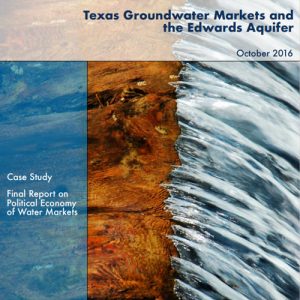Texas Groundwater Markets and the Edwards Aquifer

Introduction
Texans have a long-standing dependence on groundwater. Its usage has steadily increased throughout the state’s history. In the earliest years, farmers required groundwater for their livelihoods. In the 1930s, groundwater was an essential tool in stopping the seemingly endless Dust Bowl in the Texas Panhandle and returning the area from a wasteland to a thriving agricultural economy. The majority of rivers that start in Central Texas, and flow across the state to the bays and estuaries, find their headwaters in groundwater fed springs, without which the state could not provide sufficient surface water for many users. While groundwater has been critical to Texas’s past, it may be even more instrumental in its future.
Texas has nine major aquifers and twenty-one minor aquifers. In 2008, groundwater provided nearly sixty percent of the water used throughout the state. This amounted to 9.66 million acre-feet per year. The vast majority, eighty percent, of this water was used for irrigation. Thirty-five percent of municipal demands are met by groundwater, although this percentage may increase in the future, as surface water is increasingly unavailable. State water demands are projected to increase twenty-two percent in the next fifty years.
Even with a projected decrease in irrigation demand, the demand for groundwater will continue to increase. The state’s population is predicted to increase eighty-two percent between 2010 and 2060. The vast majority of these citizens will live in urban areas, stressing cities’ current water supplies. New water supply plans for municipal areas often include desalination of brackish aquifers or pumping and long-haul transport of groundwater from one region of the state to another. In other areas, where drought and over-allocation have reduced surface water resources, some citizens have starting drilling personal groundwater wells.
For legal purposes, groundwater is defined by the Texas Water Code as “water percolating below the surface of the earth.” This definition can be misleading as underflow of a stream is actually considered surface water and therefore under state control. Implementing regulations of Texas water rights include additional details to the definition. Groundwater is “water under the surface of the ground other than underflow of a stream and underground streams, whatever may be the geologic structure in which it is standing or moving.” Once groundwater leaves the ground in the form of springs or other discharges into a surface water body, its legal character changes and it becomes surface water and visa versa. Because surface water and groundwater are regulated separately, there is no liability when one type of use impacts the other. In other words, if permissible groundwater pumping dries up a spring that feeds surface water, there is no liability.
Unfortunately, in regions where the groundwater is hydrologically connected to nearby surface water sources, withdrawal of the groundwater reduces the available surface water. These realities, viewed in light of climate change predictions for the region, paint a bleak picture and raise questions about how the state’s aquifers will survive.
Currently, Texas considers groundwater to be private property often, but not always, associated with the surface estate. While many may object to the wisdom of this classification, it could be argued that this designation might facilitate the ability to purchase and move water from an area of plenty to one with a need. Although the notion of markets is often mentioned, few currently exist in Texas. The purpose of this paper is to evaluate current and potential water markets in the state and explore the possibility of utilizing markets to assist in water planning.
First, the paper reviews and defines groundwater law, which is the underpinning of the any property rights designation in water. Before one can discuss what a landowner can do with their property, the right must first be fully understood. This discussion reviews the legislative and case history leading to groundwater’s current management practices. This section also defines Texas’s water planning process as an overlay to property law aspect of groundwater management. As part of this analysis, a legal history of the Edwards Aquifer Authority is presented as a special case of groundwater management in Texas.
The paper then evaluates the current state of water markets in various regulatory regimes across the state weighing their strengths and weaknesses. The overarching challenge to water markets in Texas is the lack of groundwater regulation and management particularly if one of the goals of markets is to protect a groundwater resource. While the Edwards Aquifer was seen as an exception to this, recent groundwater case law could threaten this fairly successful market as well.
Note:
This case study was part of a larger research project called the Rock Report: The Political Economy of Water Markets (A Report for the Rockefeller Foundation)
The primary aim of the overall report is to identify and understand the conditions, policies and laws that lead water markets to function as a useful counterpart to other tools for sustainable water management. To that end, a central objective is to identify market, policy, institutional, legal or combined imperfections and failures that are impeding water market function.
The research effort generated the three part final report and eight case studies from varied geographies that were developed by experts in the field. Full details and reports available here: Rock Report — AMP Insights